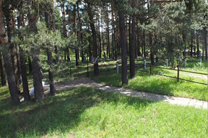
Work to renovate the Švenčionėliai mass murder site under the current plan is scheduled to begin in August and September, Švenčionys Jewish Community chairman Moisiejus Šapiro says. The period from June to November of 1941 was the most horrible and tragic period in the genocide, when about 80% of Jews in Lithuania were murdered. A ghetto was established in Švenčionys and mass murder operations were begun there. According to different sources, 7,000 to 8,000 Jews were shot across the Žeimena River in Švenčionėliai. A memorial marks the site.
Determining the exact identity of those murdered and buried near Švenčionėliai has been fraught with difficulty. After approaching numerous archives, only the names of seven Holocaust victims buried there were found. Chairman Moisiejus Šapiro is asking Holocaust survivors from the Švenčionys region and the small shtetls there and their children, grandchildren and relatives, wherever they might live now, to tell their stories and send him the names and surnames of those murdered at Švenčionėliai
He can be reached by email at moisa50@mail.ru
Here is some further information from the Vilna Gaon Jewish State Museum’s internet page.
In 1943 the Nazi administration decided to liquidate the ghettos. This was initially carried out in the Svieriai and Ašmena districts joined to the Nazi Lithuanian territorial unit. In March of 1943 the ghettos of Švenčionys, Mikailiškės, Ašmena and Salos were liquidated. About 3,000 prisoners from these ghettos were transported to the Vilnius ghetto, while others were told they were being transferred to the Kaunas ghetto. On April 5, 1943, a train filled with Jews from shtetls in Eastern Lithuania stopped at Ponar. The Jews were taken off the train and murdered in the Ponar forest. Lithuanian police participated in the shooting. In total from 4,000 to 5,000 Jews were murdered. Only a few managed to escape and return to the ghetto in Vilnius.
The Vilna Gaon Jewish State Museum continues the publication of lists of ghetto prisoners according to unique archival documents connected with the general census of residents conducted in May of 1942 in the Nazi Lithuanian territorial unit. Original census documents including lists of prisoners are conserved at the Lithuanian Central State Archive. Some of these lists have been published by Vilna Gaon Jewish State Museum, including for the Vilnius and Šiauliai ghettos.
In 2002 the four-volume “Holokaustas Lietuvoje 1941–1945: atminimo knyga” [The Holocaust in Lithuania 1941-1945: A Book of Memory] was published which provided lists of prisoners of the Vilnius and Šiauliai ghettos who were murdered during extermination operations. Included among them are lists of Jewish residents of the city and region of Švenčionys: from Švenčionys, Adutiškis, Daugėliškis, Ignalina, Kaltanėnai, Kiemeliškės, Linkmenys, Lentupis, Mielagėnai, Pabradė, Stajėtiškis and Vidžiai. These lists are collected and preserved by the Yad Vashem National Institute in Jerusalem for the commemoration of Holocaust victims and heroes, and were made according to the testimonies of Holocaust survivors. Until the compilation of these lists, the lists had been published earlier in a book published in Israel called “Švenčionys Region: A Book of Memory for Twenty-Three Jewish Communities” [in Yiddish and Hebrew, Tel Aviv, 1965].
Lists of the murdered Jews of Svieriai, Smurgainys, Ašmena and Vidžiai based on Yad Vashem material were also included in books of memory published in Israel [Our Shtetl Svieriai (Yiddish), Tel Avivas, 1959; Smurgainys. Book of Memory (Hebrew, Yiddish), Tel Avivas, 1965; Ašmena. Book of Memory (Hebrew, Yiddish), Tel Avivas, 1969; and Vidžiai. Book of Memory (Hebrew, Yiddish, English), Tel Avivas, 1997]. The same lists were provided in Belarusian and Russian lists of those who died during the war published in the multi-volume publication Памяць (Pamyat, “Memory,” Belarusian, Minsk, БЕЛТА [BELTA], 2001, 2003 and 2004).
Vilna Gaon Jewish State Museum information available in Lithuanian here.

